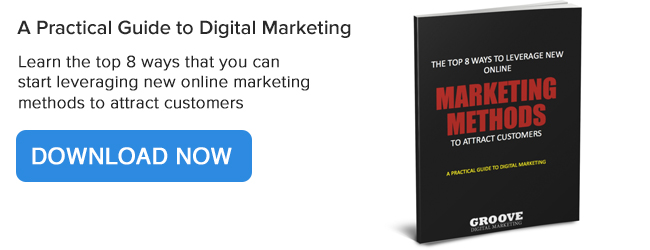 Interest in marketing automation is at an all-time high and according to SiriusDecisions, the industry is expected to grow by 50% between now and 2015. If you aren’t yet using marketing automation in your business, are you missing the boat?
Interest in marketing automation is at an all-time high and according to SiriusDecisions, the industry is expected to grow by 50% between now and 2015. If you aren’t yet using marketing automation in your business, are you missing the boat?
Does it really live up to all the hype? In today’s post, we are going to cover why marketing automation has become so incredibly popular, as well as expose you to some surprising facts. Heck, we’re even going to include a few specific use cases.
Why Is Marketing Automation All the Rage?
Because it works.
Marketing automation is just a fancy way to describe a very basic process that every business requires: give the right stuff (content and sales messages) to the right people, at the right time.
Pretty technical description, huh?
But think about that for a moment. If you are searching for a solution and find a website that has really great content, don’t you want to see more of the content that is most relevant for you? And then, at some point, if you like what you’ve seen so far, wouldn’t you like to see more information about the specific products and services that company offers?
Of course you would.
This is one of the reasons why Inbound Marketing works so well. The whole idea of inbound marketing is to become what people are interested in, instead of (using product-based advertising) to interrupt them from what they are currently interested in.
If inbound marketing is all about attracting people’s interest, marketing automation is all about ensuring you keep that interest, while simultaneously nurturing them towards a buying decision.
Marketing Automation ROI
Fact #1: According to Focus Research (slide 12):
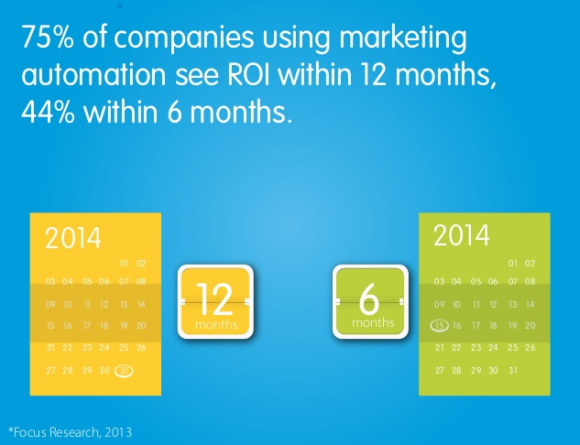
Fact #2: According to Jupiter Research:
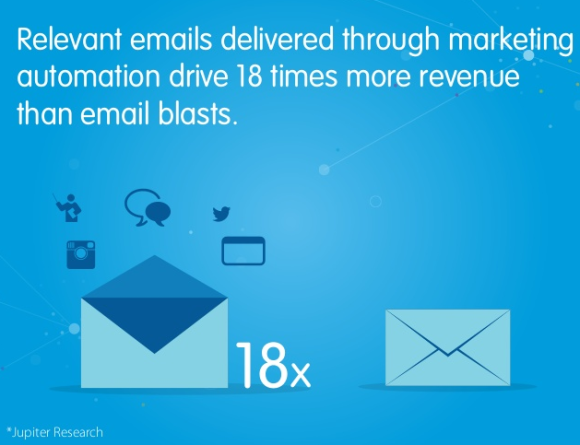
Fact #3: According to Forrester Research:
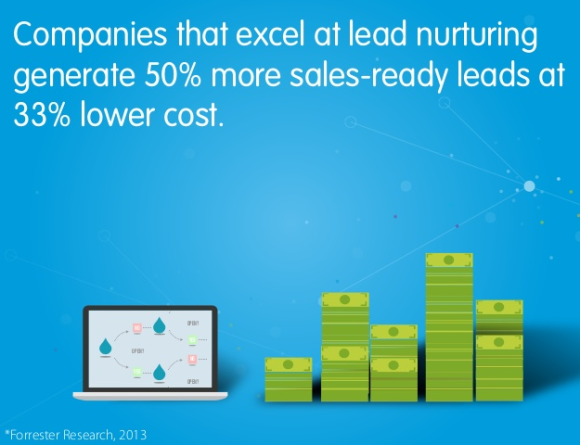
With results like this, it’s little wonder why marketing automation is so popular.
Marketing Automation Adoption Rates
Fact #4: From a low in early 2009, the number of searches for the phrase ‘marketing automation’ has steadily increased.
Fact #5: The 5 industries with the highest marketing automation adoption rates are 1. Software & Internet, 2. Telecommunications, 3. Computer & Electronics, 4. Health & Pharma, and 5. Business Services (Source: Mintigo)
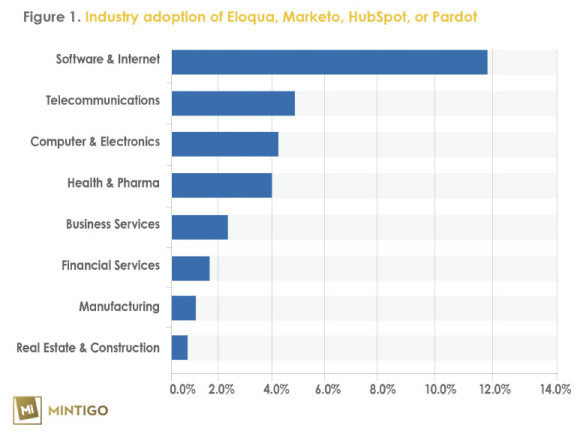
Fact #6: 41% of B2B Marketers plan to increase their marketing automation budget in 2014. (Source: PepperGlobal)
Two Examples of Marketing Automation in Action
The range of possibilities for what you can do with marketing automation is infinite. If you can draw it out on a white board, you can probably automate it. Have a look at the marketing funnel below and notice that the buyer’s journey is divided into the following three stages:
- Awareness stage
- Consideration stage
- Decision stage
The goal of the funnel is to replicate your offline sales process, as well as automate it. To do this, you will need to create interest blog articles, offer premium content, and then rely on marketing automation to make it all work.
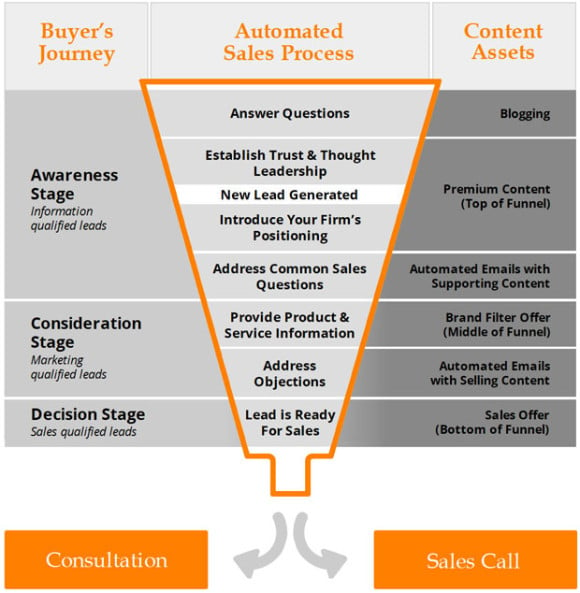
Obviously, some things are much easier to automate than others, so if you are just getting started, you’ll want to start out with the basics. Some of the basic items you should focus on first include:
Capture Leads: Having a web form on your site that will allow visitors to register and automatically receive whatever you promised them (typically a white paper)
Nurture Leads: A series of follow up emails that are sent to your new lead that provides them with additional value and offers so that when they take action, you can further segment them based upon those actions. The goal of the segmenting is to ensure that future communications are as relevant as possible.
For example, if you have 3 different buyer personas, on your web form, or at some point during the follow up sequence, you will want to get them to tell you which of the personas best describes them. You can do this either by asking directly (make a selection on a web form or “click this link if….”), or can can do it with lead scoring.
Segmenting with Lead Scoring
When you ask someone on a web form to choose one option from a list of options (like occupation), you are collecting what I like to call external data. It’s external because they know they are giving it to you.
Internal data, on the other hand, is data that you collect based upon someone’s activity. Activities can be pages viewed, emails opened, links clicked, video consumed, etc… The great part about internal data like this is that it’s hard to fake. The clicks are the clicks.
So, how do you use this? Look at the funnel up above.
Let’s suppose that you want to send your middle of funnel offer only to people who have achieved a certain lead score. How can you do that? It’s actually quite easy.
Have a look at the screenshot below. Notice in read I have created a rule that looks for people that have opened more than 2 emails. Then, in blue, I’ve given the rule a value of 2 points.
Down below that is another rule for people that have opened at least 5 emails. I’ve also created rules for how recently people have opened my emails (recency is a very important metric to track) as well as a rule for people who’ve opted out of receiving future emails. In every case, when satisfied, these rules add or subtract points from that person’s lead score.

With the criteria and rules for my lead scoring now created, I can now begin to automatically segment my leads into one of three lists as shown below. Please be aware that you can segment into as many different lists as you like. How you segment is going to be determined by your own strategy.

Once someone has been added to a list, in our case, we add them to a the workflow that is shown below. In this workflow, we send them an email asking them if they’d like to arrange a time to speak with one of our consultants. We also set their lead stage to ‘Marketing Qualified Lead’, which triggers some additional automated activities.
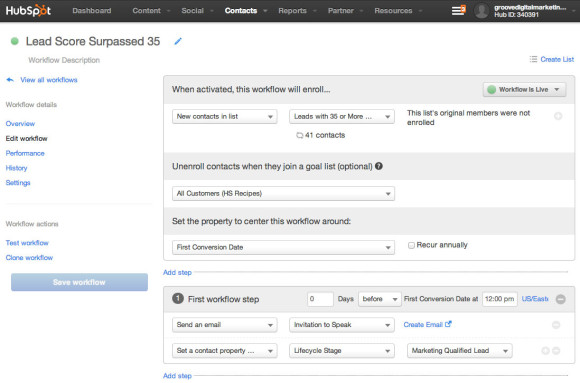
Enhance Your Follow Up With Video Tracking
Video is a very powerful way to connect with people over the web and help them to experience your brand in a very non-intrusive way. Some people will watch all of your videos. Some will watch only a portion, and some won’t watch any at all.
Wouldn’t you like to know who is who? With video tracking, you can very easily trigger any kind of automation you can dream up.
For example, when a prospect books a scoping call with us, they are sent a link to a video that we’d like them to watch before we do the call with them. The video is only about 170 seconds long, as as you can see, if they want at least 160 seconds of that video, a tag is applied.
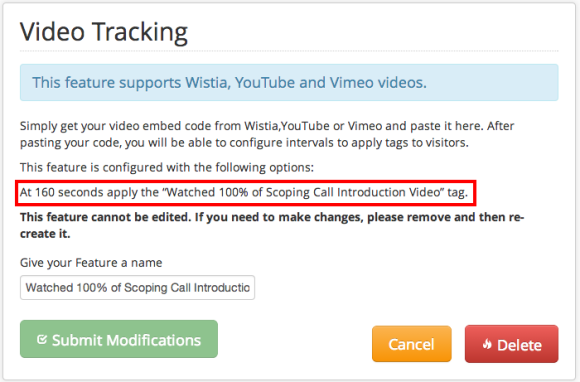
Thanks to this feature, if a prospect books a scoping call and doesn’t watch the video first, we can automatically remind them to do so. Automating this one small item saves us time (no need to manually check and remind them) as well as lets our sales team know how engaged this particular prospect is. This is just one example of the benefits of video tracking.
As with any form of automation, you are only limited by your imagination. For example, if someone watched all, or any portion you determine, of a certain video, you could automatically send them a certain sequences of emails, you could send them a white paper, you can assign a follow up call to a sales rep, or anything else you like. My point is this…video tracking is a very clear way of knowing who is engaged and who isn’t.
Hey, Thanks for the Info. Now What?
If you need any help with content creation, we have tons of free resources to get you over the hump. Please subscribe to this blog to ensure that you never miss an article.
Have questions or comments? Please use the comment form down below. We read and reply to every comment.
If you really enjoyed this post, please help us to spread the word by clicking one of the social media sharing buttons.
Thanks so much!
This post originally appeared on the Groove Digital Marketing Blog. Groove Digital Marketing is a HubSpot Partner located in Boise, ID.
